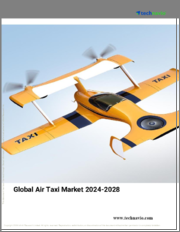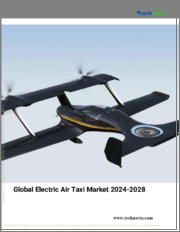
|
시장보고서
상품코드
1831982
에어택시 시장 보고서 : 추진력 유형, 항공기 유형, 승객 정원, 지역별(2025-2033년)Air Taxi Market Report by Propulsion Type (Parallel Hybrid, Electric, Turboshaft, Turboelectric), Aircraft Type (Multicopter, Quadcopter, and Others), Passenger Capacity (One, Two, Four, More than six), and Region 2025-2033 |
||||||
세계의 에어택시 시장 규모는 2024년에 13억 3,090만 달러에 달했습니다. 향후 IMARC Group은 시장이 2033년까지 45억 5,500만 달러에 달하며, 2025-2033년에 14.6%의 성장률(CAGR)을 보일 것으로 예측하고 있습니다. 도시화의 진전, 교통 정체, 기술의 진보, 정부 구상 강화, 인프라 정비 등이 시장의 성장을 지원하고 있습니다.
에어택시 시장 동향
도시화와 교통체증 증가
급속한 도시화와 대도시의 교통 체증 증가는 대체 교통 솔루션에 대한 수요를 촉진하고 있습니다. 예를 들어 영국의 전체 교통량은 2023년에 2022년보다 2023년에 증가했습니다. 영국 도로의 자동차 교통량은 2022-2023년 사이 2.2% 증가하여 3,308억 차량 마일을 기록할 것으로 예측됩니다. 에어택시는 지상 교통을 우회하고 이동 시간을 단축할 수 있는 방법을 제공하여 도시 이동의 문제를 해결합니다. 이러한 요인으로 인해 향후 수년간 에어택시 시장이 활성화될 것으로 예측됩니다.
연구개발 활동 활성화
시장 성장의 주요 촉진요인 중 하나는 플라잉 택시의 연구개발 활동 증가입니다. 많은 기업 및 단체들이 플라잉 택시를 개발하고 시장에서 상품화하기 위해 많은 연구개발비를 투자하고 있습니다. 예를 들어 2024년 6월 캘리포니아 암스트롱 비행 연구센터의 NASA 연구원들은 미래의 에어택시 서비스에서 고객의 편안함과 경험을 테스트하기 위해 독특한 가상현실(VR) 비행 시뮬레이터를 제작했습니다. 이러한 요인들은 에어택시 시장 예측에 더욱 긍정적인 영향을 미칠 것입니다.
기술 혁신
VTOL 기능을 통해 에어택시는 수직 이착륙이 가능하므로 긴 활주로가 필요 없어 도심 환경에서도 운항이 가능합니다. 이 기술은 에어택시를 도시 풍경에 녹여 단거리 이동에 실용화할 수 있는 열쇠가 될 것입니다. 예를 들어 2024년 4월 INDIGO는 미국에 본사를 둔 Archer Aviation과 제휴하여 인도에서 전기식 에어택시 서비스를 발표했습니다. 이 합작회사는 델리와 구루그람을 오가는 승객들에게 효율적이고 친환경적인 항공 여행 옵션을 제공함으로써 도시 교통을 재정의하는 것을 목표로 하고 있습니다. 미드나이트 비행기로 알려진 eVTOL 기종은 소음 수준이 낮고 안전 대책이 개선되어 에어택시 시장의 매출을 높일 수 있습니다.
목차
제1장 서문
제2장 조사 범위와 조사 방법
- 조사의 목적
- 이해관계자
- 데이터 소스
- 1차 정보
- 2차 정보
- 시장 추정
- 보텀업 어프로치
- 톱다운 어프로치
- 조사 방법
제3장 개요
제4장 서론
제5장 세계의 에어택시 시장
- 시장 개요
- 시장 실적
- COVID-19의 영향
- 시장 예측
제6장 시장 내역 : 추진력 유형별
- 패러렐 하이브리드
- 전기
- 터보샤프트
- 터보일렉트릭
제7장 시장 내역 : 항공기 유형별
- 멀티콥터
- 쿼드콥터
- 기타
제8장 시장 내역 : 승객 정원별
- 1명
- 2명
- 4명
- 6명 이상
제9장 시장 내역 : 지역별
- 북미
- 미국
- 캐나다
- 아시아태평양
- 중국
- 일본
- 인도
- 한국
- 호주
- 인도네시아
- 기타
- 유럽
- 독일
- 프랑스
- 영국
- 이탈리아
- 스페인
- 러시아
- 기타
- 라틴아메리카
- 브라질
- 멕시코
- 기타
- 중동 및 아프리카
제10장 SWOT 분석
제11장 밸류체인 분석
제12장 Porter's Five Forces 분석
제13장 가격 분석
제14장 경쟁 구도
- 시장 구조
- 주요 기업
- 주요 기업의 개요
- Ab Corporate Aviation
- Airbus SE
- Fly Aeolus
- Honeywell International Inc.
- Hyundai Motor Company
- Joby Aviation
- Kitty Hawk Corporation
- Neva Aerospace Ltd.
- Nurol Holding
- Skyway Air Taxi
- Talkeetna Air Taxi Inc
- Volocopter GmbH
The global air taxi market size reached USD 1,330.9 Million in 2024. Looking forward, IMARC Group expects the market to reach USD 4,555.0 Million by 2033, exhibiting a growth rate (CAGR) of 14.6% during 2025-2033. The growing urbanization, traffic congestion, ongoing technological advancements, the increasing government initiatives, and infrastructure development are primarily propelling the market's growth.
Air Taxi Market Trends:
Rising Urbanization and Traffic Congestion
Rapid urbanization and increasing traffic congestion in major cities drive the demand for alternative transportation solutions. For instance, overall traffic volumes in Great Britain were higher in 2023 than in 2022. Motor vehicle traffic on British roadways increased by 2.2% between 2022 and 2023, reaching 330.8 billion vehicle miles. Air taxis offer a way to bypass ground traffic and reduce travel time, addressing the challenges of urban mobility. These factors are expected to propel the air taxi market in the coming years.
Increasing Research and Development Activities
One of the key drivers of market growth is an increase in research and development activities for flying taxis. Many companies and organizations are extensively spending on R&D to create and commercialize flying taxis in the market. For instance, in June 2024, NASA researchers at the Armstrong Flight Research Centre in California created a unique virtual reality (VR) flight simulator to test customer comfort and experience in future air taxi services. These factors further positively influence the air taxi market forecast.
Technological Innovations
VTOL capabilities allow air taxis to take off and land vertically, eliminating the need for long runways and enabling operations in urban environments. This technology is key to integrating air taxis into city landscapes and making them practical for short-distance travel. For instance, in April 2024, INDIGO partnered with US-based Archer Aviation to unveil an all-electric air taxi service in India. The joint company intends to redefine urban transportation by providing efficient, environmentally friendly air travel options for passengers traveling between Delhi and Gurugram. The eVTOL aircraft, known as the Midnight plane, has lower noise levels and improved safety precautions, thereby boosting the air taxi market revenue.
Global Air Taxi Industry Segmentation:
Breakup by Propulsion Type:
- Parallel Hybrid
- Electric
- Turboshaft
- Turboelectric
Electric currently holds the largest market share
According to the air taxi market outlook, electric air taxis produce zero tailpipe emissions, aligning with global goals to reduce carbon footprints and combat climate change. They offer a cleaner alternative to traditional fossil-fuel-powered aircraft. Moreover, electric propulsion systems are generally quieter than conventional engines, making them more suitable for urban environments where noise pollution is a concern. Apart from this, advances in battery technology, such as increased energy density and faster charging, are making electric air taxis more viable. This helps extend flight ranges and reduces downtime for recharging.
Breakup by Aircraft Type:
- Multicopter
- Quadcopter
- Others
Multicopter exhibits a clear dominance in the market
According to the air taxi market overview, multicopter air taxis offer a solution to urban traffic congestion by providing a new mode of transportation that bypasses ground-level traffic jams, making city travel faster and more efficient. They enable direct, point-to-point travel within cities, reducing travel time compared to traditional ground-based transportation. Moreover, improvements in battery life and energy density are making multicopters more viable for longer flights, enhancing their operational range and efficiency. Apart from this, many governments are supporting the development of eVTOL and multicopter technologies through grants, subsidies, and favorable regulations. This support accelerates development and deployment.
Breakup by Passenger Capacity:
- One
- Two
- Four
- More than six
One-passenger capacity air taxi is ideal for individuals seeking a high level of personal convenience and privacy. This configuration is often targeted towards high-net-worth individuals and executives. Moreover, two-passenger capacity taxi is suited for couples or small business partners who need a shared transportation option that is still compact and efficient. Apart from this, four-passenger capacity appeals to families or small groups who need to travel together. This capacity offers a balance between personal convenience and group functionality. Furthermore, more than six-passenger capacity air taxis are suited for commercial applications, such as shuttle services between airports, hotels, and tourist destinations.
Breakup by Region:
- North America
- United States
- Canada
- Asia-Pacific
- China
- Japan
- India
- South Korea
- Australia
- Indonesia
- Others
- Europe
- Germany
- France
- United Kingdom
- Italy
- Spain
- Russia
- Others
- Latin America
- Brazil
- Mexico
- Others
- Middle East and Africa
North America currently dominates the global market
The report has also provided a comprehensive analysis of all the major regional markets, which include North America (the United States and Canada); Europe (Germany, France, the United Kingdom, Italy, Spain, Russia and others); Asia Pacific (China, Japan, India, South Korea, Australia, Indonesia, and others); Latin America (Brazil, Mexico, and others); and the Middle East and Africa. According to the report, North America currently dominates the global market.
According to the air taxi market statistics, rapid urbanization and increasing traffic congestion in major cities are driving demand for alternative transportation solutions in the region. Air taxis offer a potential solution for bypassing ground traffic and reducing travel times. Moreover, there is increasing consumer interest in innovative and convenient mobility solutions. Air taxis can provide premium travel experience with faster and more direct routes, catering to a growing market of affluent and tech-savvy individuals. Apart from this, support from government agencies, including initiatives for regulatory frameworks and infrastructure development, is crucial. Regulatory bodies like the FAA are working on developing standards for air taxi operations, which helps in advancing the market.
Competitive Landscape:
The market research report has provided a comprehensive analysis of the competitive landscape. Detailed profiles of all major market companies have also been provided. Some of the key players in the market include:
- Ab Corporate Aviation
- Airbus SE
- Fly Aeolus
- Honeywell International Inc.
- Hyundai Motor Company
- Joby Aviation
- Kitty Hawk Corporation
- Neva Aerospace Ltd.
- Nurol Holding
- Skyway Air Taxi
- Talkeetna Air Taxi Inc.
- Volocopter GmbH
Key Questions Answered in This Report
- 1.What was the size of the global air taxi market in 2024?
- 2.What is the expected growth rate of the global air taxi market during 2025-2033?
- 3.What are the key factors driving the global air taxi market?
- 4.What has been the impact of COVID-19 on the global air taxi market?
- 5.What is the breakup of the global air taxi market based on the propulsion type?
- 6.What is the breakup of the global air taxi market based on the aircraft type?
- 7.What are the key regions in the global air taxi market?
- 8.Who are the key players/companies in the global air taxi market?
Table of Contents
1 Preface
2 Scope and Methodology
- 2.1 Objectives of the Study
- 2.2 Stakeholders
- 2.3 Data Sources
- 2.3.1 Primary Sources
- 2.3.2 Secondary Sources
- 2.4 Market Estimation
- 2.4.1 Bottom-Up Approach
- 2.4.2 Top-Down Approach
- 2.5 Forecasting Methodology
3 Executive Summary
4 Introduction
- 4.1 Overview
- 4.2 Key Industry Trends
5 Global Air Taxi Market
- 5.1 Market Overview
- 5.2 Market Performance
- 5.3 Impact of COVID-19
- 5.4 Market Forecast
6 Market Breakup by Propulsion Type
- 6.1 Parallel Hybrid
- 6.1.1 Market Trends
- 6.1.2 Market Forecast
- 6.2 Electric
- 6.2.1 Market Trends
- 6.2.2 Market Forecast
- 6.3 Turboshaft
- 6.3.1 Market Trends
- 6.3.2 Market Forecast
- 6.4 Turboelectric
- 6.4.1 Market Trends
- 6.4.2 Market Forecast
7 Market Breakup by Aircraft Type
- 7.1 Multicopter
- 7.1.1 Market Trends
- 7.1.2 Market Forecast
- 7.2 Quadcopter
- 7.2.1 Market Trends
- 7.2.2 Market Forecast
- 7.3 Others
- 7.3.1 Market Trends
- 7.3.2 Market Forecast
8 Market Breakup by Passenger Capacity
- 8.1 One
- 8.1.1 Market Trends
- 8.1.2 Market Forecast
- 8.2 Two
- 8.2.1 Market Trends
- 8.2.2 Market Forecast
- 8.3 Four
- 8.3.1 Market Trends
- 8.3.2 Market Forecast
- 8.4 More than six
- 8.4.1 Market Trends
- 8.4.2 Market Forecast
9 Market Breakup by Region
- 9.1 North America
- 9.1.1 United States
- 9.1.1.1 Market Trends
- 9.1.1.2 Market Forecast
- 9.1.2 Canada
- 9.1.2.1 Market Trends
- 9.1.2.2 Market Forecast
- 9.1.1 United States
- 9.2 Asia-Pacific
- 9.2.1 China
- 9.2.1.1 Market Trends
- 9.2.1.2 Market Forecast
- 9.2.2 Japan
- 9.2.2.1 Market Trends
- 9.2.2.2 Market Forecast
- 9.2.3 India
- 9.2.3.1 Market Trends
- 9.2.3.2 Market Forecast
- 9.2.4 South Korea
- 9.2.4.1 Market Trends
- 9.2.4.2 Market Forecast
- 9.2.5 Australia
- 9.2.5.1 Market Trends
- 9.2.5.2 Market Forecast
- 9.2.6 Indonesia
- 9.2.6.1 Market Trends
- 9.2.6.2 Market Forecast
- 9.2.7 Others
- 9.2.7.1 Market Trends
- 9.2.7.2 Market Forecast
- 9.2.1 China
- 9.3 Europe
- 9.3.1 Germany
- 9.3.1.1 Market Trends
- 9.3.1.2 Market Forecast
- 9.3.2 France
- 9.3.2.1 Market Trends
- 9.3.2.2 Market Forecast
- 9.3.3 United Kingdom
- 9.3.3.1 Market Trends
- 9.3.3.2 Market Forecast
- 9.3.4 Italy
- 9.3.4.1 Market Trends
- 9.3.4.2 Market Forecast
- 9.3.5 Spain
- 9.3.5.1 Market Trends
- 9.3.5.2 Market Forecast
- 9.3.6 Russia
- 9.3.6.1 Market Trends
- 9.3.6.2 Market Forecast
- 9.3.7 Others
- 9.3.7.1 Market Trends
- 9.3.7.2 Market Forecast
- 9.3.1 Germany
- 9.4 Latin America
- 9.4.1 Brazil
- 9.4.1.1 Market Trends
- 9.4.1.2 Market Forecast
- 9.4.2 Mexico
- 9.4.2.1 Market Trends
- 9.4.2.2 Market Forecast
- 9.4.3 Others
- 9.4.3.1 Market Trends
- 9.4.3.2 Market Forecast
- 9.4.1 Brazil
- 9.5 Middle East and Africa
- 9.5.1 Market Trends
- 9.5.2 Market Breakup by Country
- 9.5.3 Market Forecast
10 SWOT Analysis
- 10.1 Overview
- 10.2 Strengths
- 10.3 Weaknesses
- 10.4 Opportunities
- 10.5 Threats
11 Value Chain Analysis
12 Porters Five Forces Analysis
- 12.1 Overview
- 12.2 Bargaining Power of Buyers
- 12.3 Bargaining Power of Suppliers
- 12.4 Degree of Competition
- 12.5 Threat of New Entrants
- 12.6 Threat of Substitutes
13 Price Analysis
14 Competitive Landscape
- 14.1 Market Structure
- 14.2 Key Players
- 14.3 Profiles of Key Players
- 14.3.1 Ab Corporate Aviation
- 14.3.1.1 Company Overview
- 14.3.1.2 Product Portfolio
- 14.3.2 Airbus SE
- 14.3.2.1 Company Overview
- 14.3.2.2 Product Portfolio
- 14.3.2.3 Financials
- 14.3.2.4 SWOT Analysis
- 14.3.3 Fly Aeolus
- 14.3.3.1 Company Overview
- 14.3.3.2 Product Portfolio
- 14.3.4 Honeywell International Inc.
- 14.3.4.1 Company Overview
- 14.3.4.2 Product Portfolio
- 14.3.4.3 Financials
- 14.3.4.4 SWOT Analysis
- 14.3.5 Hyundai Motor Company
- 14.3.5.1 Company Overview
- 14.3.5.2 Product Portfolio
- 14.3.5.3 Financials
- 14.3.5.4 SWOT Analysis
- 14.3.6 Joby Aviation
- 14.3.6.1 Company Overview
- 14.3.6.2 Product Portfolio
- 14.3.7 Kitty Hawk Corporation
- 14.3.7.1 Company Overview
- 14.3.7.2 Product Portfolio
- 14.3.8 Neva Aerospace Ltd.
- 14.3.8.1 Company Overview
- 14.3.8.2 Product Portfolio
- 14.3.9 Nurol Holding
- 14.3.9.1 Company Overview
- 14.3.9.2 Product Portfolio
- 14.3.10 Skyway Air Taxi
- 14.3.10.1 Company Overview
- 14.3.10.2 Product Portfolio
- 14.3.11 Talkeetna Air Taxi Inc
- 14.3.11.1 Company Overview
- 14.3.11.2 Product Portfolio
- 14.3.12 Volocopter GmbH
- 14.3.12.1 Company Overview
- 14.3.12.2 Product Portfolio
- 14.3.1 Ab Corporate Aviation

















